Pumping Station Desing - Second Edition by Robert L. Sanks, George Tchobahoglous, Garr M. Jones
Подождите немного. Документ загружается.


Figure
29-17.
Wet
well
plus approach
pipe
volumes
and
pump
cycle
times
for two
main
duty
pumps
(15.1
ft
3
/s
each)
alternated.
active
storage volume required
was no
less,
the
needed volume could
be
obtained with either
(1)
a
longer approach pipe
and a
shorter, deeper
wet
well
or (2) by
retaining
the
same dimensions.
The
latter option
was
chosen,
and the
plans
are the
same
as
those
of
Figure
29-15
except that
there
are
three pumps instead
of
four.
A
diagram
of the
pump-cycling
frequency
is
shown
in
Figure
29-17.
The
start
and
stop eleva-
tions
had to be
changed
to
accommodate
the
omission
of the
jockey pump,
but the
greater vol-
ume
required
for the
larger starting pump could
be
reduced
by
alternating
the
pumps
in
successive
cycles—a
common expedient that cuts
the
required cycle time
in
half.
Figure
29-16.
Wet
well
plus approach
pipe
volumes
and
pump-cycle
times. Jockey
pump
(7.80
ft
3
/s) is
P1,
main
pumps
(15.1
ft
3
/s
each)
are
P2,
P3,
or P4.

Labor
Material
Sub
Equipment
Sales
GRP
Process
Amount
Amount
Amount
Amount
Tax
Markup
Total
#
Area
M/C
Hrs
a
($) ($) ($) ($) ($) ($) ($) Job %
010
Contractor
Indirects
1,384 65,394
608
2,450 14,490
36
11,744 94,722 11.3%
015
Yard
Development
192
3,955 6,570
480 981
11,986 1.4%
018
Sewer Pipe
84
2,494 7,040 5,645 1,230
422
1,648 18,479 2.2%
020
Pump Station 1,042 25,125 215,997 111,588 4,616 12,962 35,822
406,110
48.6%
022
Valve
Vault
354
8,965 17,187 1,069 1,029 3,535 31,785 3.8%
176
Elect/instr
260,000
13,000
273,000 32.7%
Estimate
Subtotal: 3,052
$105,933
$240,832
$386,253
$21,885
$14,449
$66,730
$836,082
100.0%
Plus
Bond,
if
Required:
$8,361
1.0%
Revised
Subtotal:
$844,443
101.0%
Contingency:
$
126,666 15.0%
GRAND
TOTAL:
$
971,109
a
Man-h/Crew-h
One
unresolved
difficulty
is
that
the use of fixed
stop levels produces
end-of-cycle
entrance
velocities that,
for
Pl,
would vary
from
4.0 to
less than
1
ft/s.
To
avoid
the
buildup
of
deposits
not
expelled
at
velocities much less than about
2.5
ft/s,
a PLC
could
be
programmed
to
lower
the
stop level
for low flows.
Inflow
can be
approximately quantified
by
programming
the
com-
puter
to
measure
the
time period
for the up leg of the
pump cycle.
Construction
Costs
Construction
costs estimated
for the
three design options above
are
based
on the
prevailing
wage
rates
for the
Atlanta, Georgia, area, with
an ENR
20-cities
average
of
5798.
For a
graphic
presentation
of the
effects
that
specific
ground
and
soils conditions
can
have
on the
costs
of a
particular
pumping station,
two
estimates were made
for
each design option:
(1)
one for
good
soil conditions
and (2) one for
poor soils with high ground water.
The
difference
in
costs
is due
to the
need
for
water-tight sheet piling
and
dewatering
in
poor soils.
A
single cost estimate, even
at
this budget stage, requires seven pages
of fine
print
and is
thus
too
lengthy
to
include herein,
but a
typical summary
is
presented
in
Table
29-1.
Grand totals
for
all six
cost estimates
are
given
in
Table 29-2.
Project:
Pumping station cost, poor soil
3
pump
V/S
system
Made
by:
Pritchard/Abelin
Checked
by:
Summary
totals
Labor: $105,933 Sales Tax:
$
14,449
Material:
$240,832 Markup:
$
66,730
Subs:
$386,253 Subtotal: $836,082
Equipment:
$
21,885 Bond:
$
8,361
Revised
Subtotal: $844,443
Contingency: $126,666
Grand
Total: $971,109
Estimate
#:
11
UCl
Job#:
Figure 29-12
Estdate:
6-17-97
PRT
date: 10-11-97
PRT
time: 8:49
pm
Markup
data
Labor
M/U:
15.00% Sales
Tax
(Mat'l)
:
6.00%
Material MAJ: 12.00% Sales
Tax
(Equip): .00%
Subs
MAJ: 5.00% Bond Rate: 1.00%
Equipment
MAJ: 12.00% Contingency: 15.00%
Table
29-1.
Estimate Summary Sheet
for a
Pumping
Station
in
Poor
Soil.
Three
V/S
Pumps. Courtesy
of
Brown
and
Caldwell
Consultants,
Construction
Management
Division.
ESTIMATE
SUMMARY
SHEET
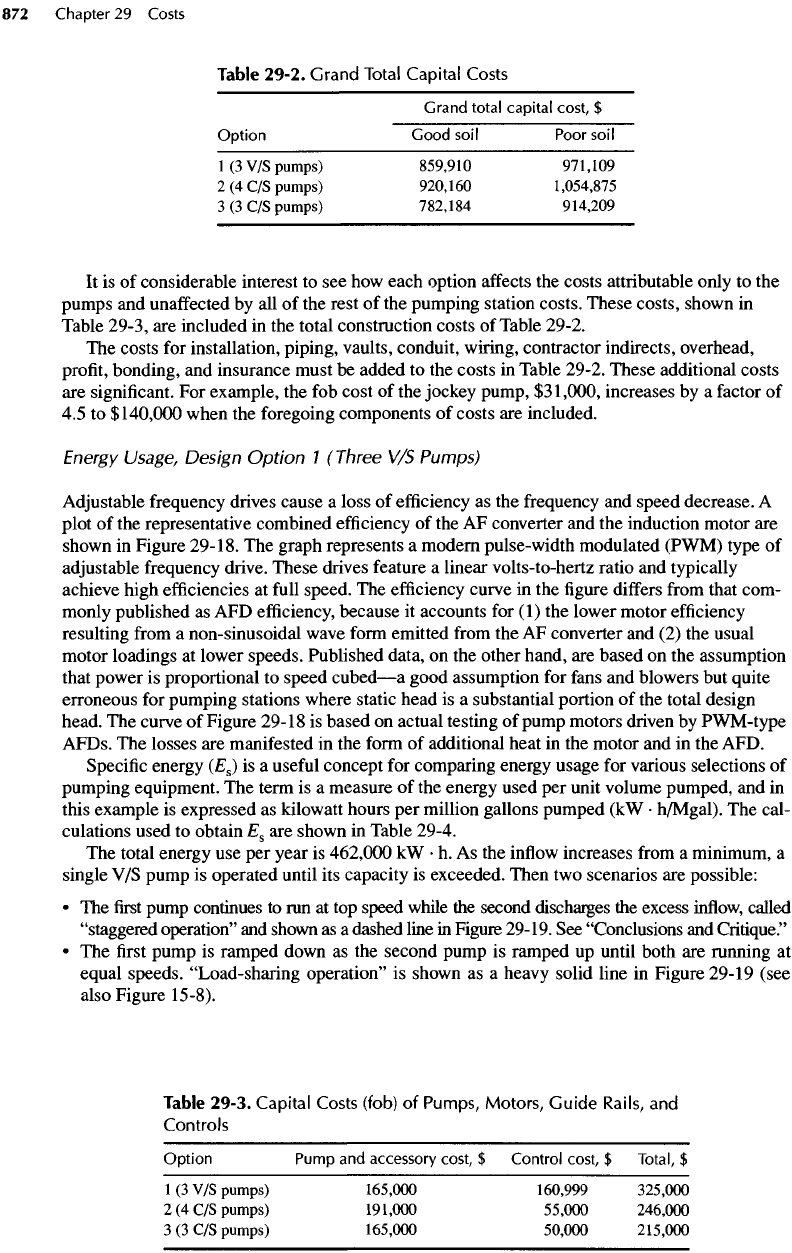
Table 29-2.
Grand
Total
Capital
Costs
Grand
total
capital
cost,
$
Option Good
soil
Poor
soil
1 (3 V/S
pumps) 859,910 971,109
2(4C/Spumps)
920,160 1,054,875
3(3C/Spumps)
782,184 914,209
It
is of
considerable interest
to see how
each option
affects
the
costs attributable only
to the
pumps
and
unaffected
by all of the
rest
of the
pumping station costs. These costs, shown
in
Table 29-3,
are
included
in the
total construction costs
of
Table 29-2.
The
costs
for
installation, piping, vaults, conduit, wiring, contractor indirects, overhead,
profit,
bonding,
and
insurance must
be
added
to the
costs
in
Table 29-2. These additional costs
are
significant.
For
example,
the fob
cost
of the
jockey pump,
$31,000,
increases
by a
factor
of
4.5 to
$140,000
when
the
foregoing components
of
costs
are
included.
Energy
Usage,
Design
Option
1
(Three
V/S
Pumps)
Adjustable
frequency
drives cause
a
loss
of
efficiency
as the
frequency
and
speed decrease.
A
plot
of the
representative combined
efficiency
of the AF
converter
and the
induction motor
are
shown
in
Figure
29-18.
The
graph represents
a
modern
pulse-width
modulated (PWM) type
of
adjustable
frequency drive. These drives feature
a
linear
volts-to-hertz
ratio
and
typically
achieve high efficiencies
at
full
speed.
The
efficiency
curve
in the figure
differs
from
that com-
monly
published
as AFD
efficiency,
because
it
accounts
for (1) the
lower motor
efficiency
resulting
from
a
non-sinusoidal wave
form
emitted
from
the AF
converter
and (2) the
usual
motor loadings
at
lower speeds. Published data,
on the
other hand,
are
based
on the
assumption
that
power
is
proportional
to
speed
cubed—a
good assumption
for
fans
and
blowers
but
quite
erroneous
for
pumping stations where static head
is a
substantial portion
of the
total design
head.
The
curve
of
Figure
29-18
is
based
on
actual testing
of
pump motors driven
by
PWM-type
AFDs.
The
losses
are
manifested
in the
form
of
additional heat
in the
motor
and in the
AFD.
Specific
energy
(E
8
)
is a
useful
concept
for
comparing energy usage
for
various selections
of
pumping
equipment.
The
term
is a
measure
of the
energy used
per
unit volume pumped,
and in
this
example
is
expressed
as
kilowatt hours
per
million gallons pumped
(kW •
h/Mgal).
The
cal-
culations used
to
obtain
E
8
are
shown
in
Table 29-4.
The
total energy
use per
year
is
462,000
kW • h. As the
inflow
increases
from
a
minimum,
a
single
V/S
pump
is
operated until
its
capacity
is
exceeded. Then
two
scenarios
are
possible:
• The first
pump continues
to run at top
speed while
the
second discharges
the
excess
inflow,
called
"staggered
operation"
and
shown
as a
dashed line
in
Figure 29-19.
See
"Conclusions
and
Critique."
• The first
pump
is
ramped down
as the
second pump
is
ramped
up
until both
are
running
at
equal speeds. "Load-sharing
operation"
is
shown
as a
heavy solid line
in
Figure 29-19 (see
also Figure 15-8).
Table 29-3.
Capital
Costs (fob)
of
Pumps,
Motors,
Guide
Rails,
and
Controls
Option
Pump
and
accessory
cost,
$
Control
cost,
$
Total,
$
1
(3 V/S
pumps)
165,000
160,999
325,000
2
(4 C/S
pumps)
191,000
55,000
246,000
3(3C/Spumps)
165,000
50,000
215,000
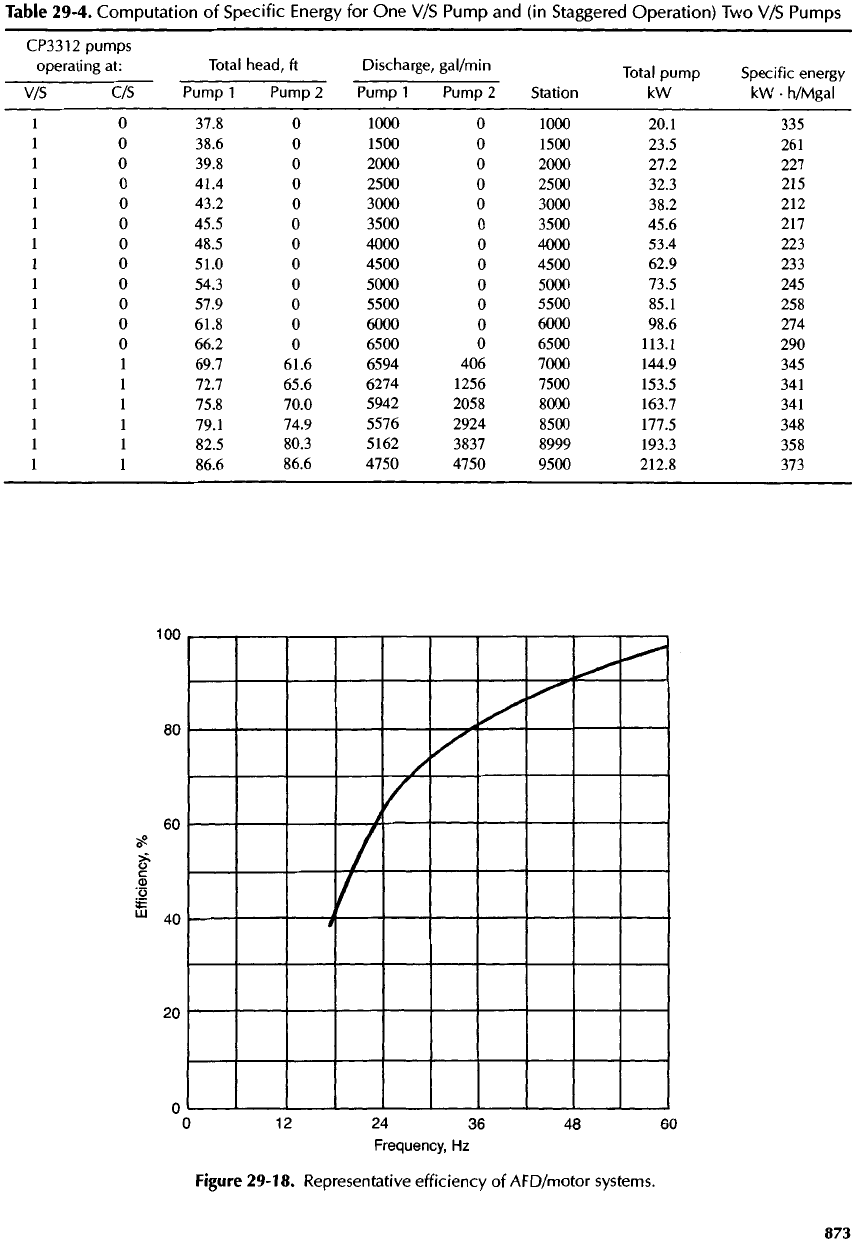
Table
29-4.
Computation
of
Specific
Energy
for One V/S
Pump
and (in
Staggered
Operation)
Two V/S
Pumps
CP3312
pumps
operating
at:
Total
head,
ft
Discharge,
gal/min
Total
pump
Specific
energy
V/S
C/S
Pump
1
Pump
2
Pump
1
Pump
2
Station
kW kW •
h/Mgal
1 O
37.8
O
1000
O
1000 20.1
335
1 O
38.6
O
1500
O
1500 23.5
261
1 O
39.8
O
2000
O
2000 27.2
227
1 O
41.4
O
2500
O
2500 32.3
215
1 O
43.2
O
3000
O
3000 38.2
212
1 O
45.5
O
3500
O
3500 45.6
217
1 O
48.5
O
4000
O
4000 53.4
223
1 O
51.0
O
4500
O
4500 62.9
233
1 O
54.3
O
5000
O
5000 73.5
245
O
57.9
O
5500
O
5500 85.1
258
O
61.8
O
6000
O
6000 98.6
274
0
66.2
O
6500
O
6500 113.1
290
1
69.7 61.6 6594
406
7000 144.9
345
1
72.7 65.6 6274 1256 7500 153.5
341
1
75.8 70.0 5942 2058 8000 163.7
341
1
79.1 74.9 5576 2924 8500 177.5
348
1
82.5 80.3 5162 3837 8999 193.3
358
1 1
86.6 86.6 4750 4750 9500 212.8
373
Figure
29-18. Representative efficiency
of
AFD/motor
systems.
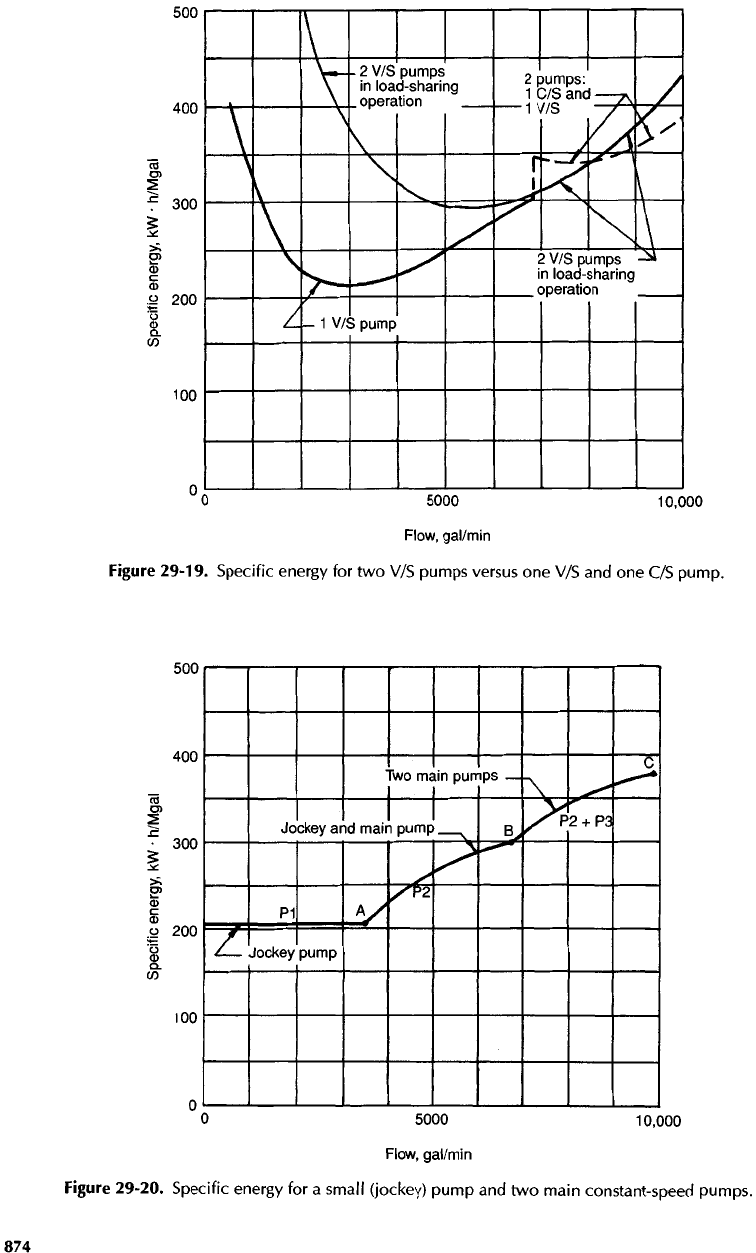
Figure
29-19.
Specific energy
for two V/S
pumps
versus
one V/S and one C/S
pump.
Figure
29-20. Specific energy
for a
small (jockey)
pump
and two
main constant-speed pumps.
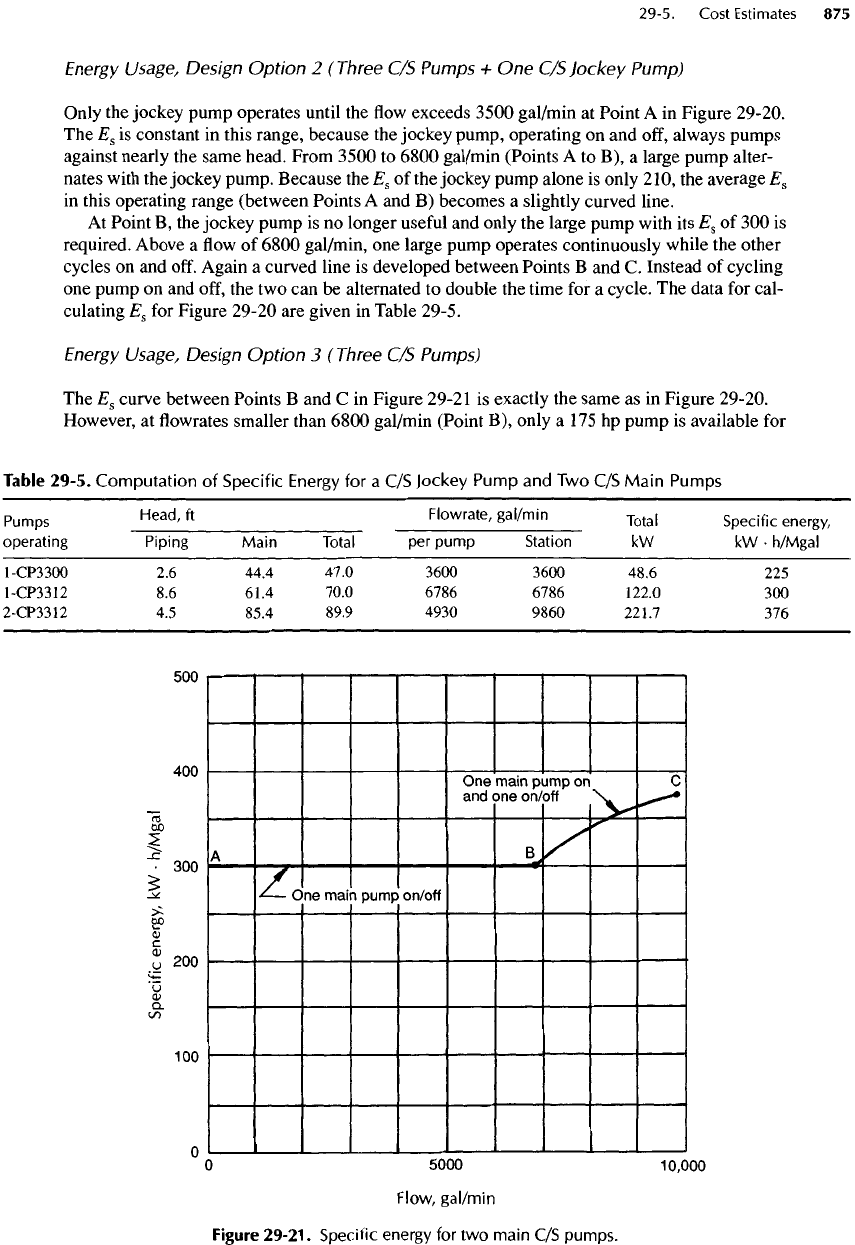
Energy
Usage,
Design
Option
2
(Three
C/S
Pumps
+ One
C/S
Jockey
Pump)
Only
the
jockey pump operates until
the flow
exceeds
3500
gal/min
at
Point
A in
Figure 29-20.
The
E
8
is
constant
in
this range, because
the
jockey pump, operating
on and
off, always pumps
against
nearly
the
same head. From 3500
to
6800
gal/min (Points
A to B), a
large pump alter-
nates
with
the
jockey pump. Because
the
E
s
of the
jockey pump alone
is
only
210,
the
average
E
8
in
this operating range (between Points
A and
B)
becomes
a
slightly curved line.
At
Point
B,
the
jockey pump
is no
longer
useful
and
only
the
large pump with
its
E
8
of 300 is
required. Above
a flow of
6800
gal/min,
one
large pump operates continuously while
the
other
cycles
on and
off. Again
a
curved line
is
developed between Points
B and C.
Instead
of
cycling
one
pump
on and
off,
the two can be
alternated
to
double
the
time
for a
cycle.
The
data
for
cal-
culating
E
8
for
Figure 29-20
are
given
in
Table
29-5.
Energy
Usage,
Design
Option
3
(Three
C/S
Pumps)
The
E
8
curve between Points
B and C in
Figure 29-21
is
exactly
the
same
as in
Figure 29-20.
However,
at flowrates
smaller than
6800
gal/min (Point
B),
only
a
175
hp
pump
is
available
for
Table
29-5.
Computation
of
Specific Energy
for a C/S
Jockey
Pump
and Two C/S
Main
Pumps
Pumps
Head
'
ft
Flowrate,
gal/min
Tota|
Specific
energy,
operating
Piping Main
Total
per
pump
Station
kW kW •
h/Mgal
1-CP3300
2.6
44.4 47.0
3600 3600
48.6
225
1-CP3312
8.6
61.4 70.0
6786 6786
122.0
300
2-CP3312
4.5
85.4 89.9
4930 9860
221.7
376
Figure
29-21.
Specific energy
for two
main
C/S
pumps.
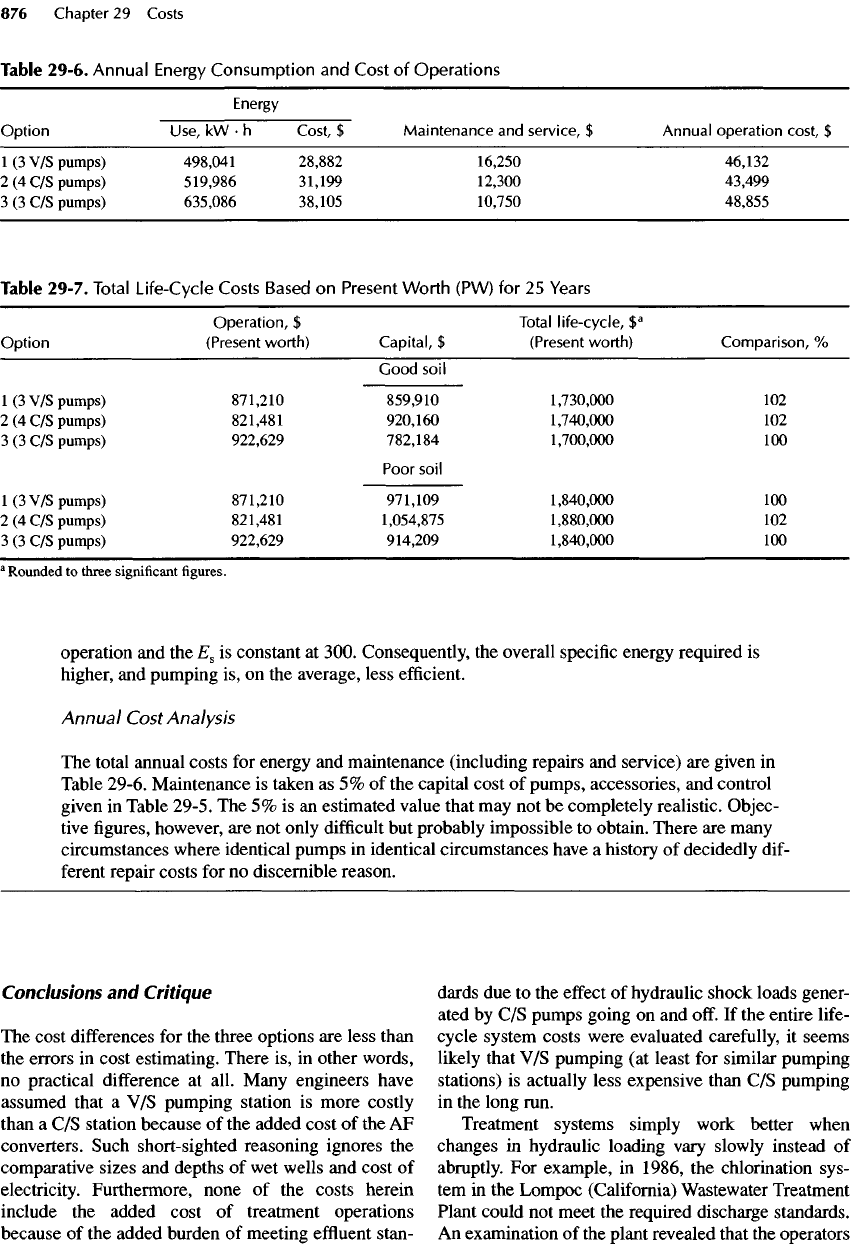
Conclusions
and
Critique
The
cost
differences
for the
three options
are
less than
the
errors
in
cost estimating. There
is, in
other words,
no
practical
difference
at
all. Many engineers have
assumed
that
a V/S
pumping station
is
more costly
than
a C/S
station because
of the
added cost
of the AF
converters. Such short-sighted reasoning ignores
the
comparative sizes
and
depths
of wet
wells
and
cost
of
electricity.
Furthermore,
none
of the
costs
herein
include
the
added cost
of
treatment operations
because
of the
added burden
of
meeting
effluent
stan-
dards
due to the
effect
of
hydraulic shock loads gener-
ated
by C/S
pumps going
on and
off.
If the
entire
life-
cycle system costs were evaluated
carefully,
it
seems
likely that
V/S
pumping
(at
least
for
similar pumping
stations)
is
actually less expensive than
C/S
pumping
in
the
long run.
Treatment systems simply work better when
changes
in
hydraulic loading vary slowly instead
of
abruptly.
For
example,
in
1986,
the
chlorination
sys-
tem
in the
Lompoc (California) Wastewater Treatment
Plant could
not
meet
the
required discharge standards.
An
examination
of the
plant revealed that
the
operators
Table
29-6. Annual
Energy
Consumption
and
Cost
of
Operations
Energy
Option
Use,
kW • h
Cost,
$
Maintenance
and
service,
$
Annual
operation
cost,
$
1 (3 V/S
pumps)
498,041 28,882 16,250 46,132
2(4C/Spumps)
519,986 31,199 12,300 43,499
3 (3 C/S
pumps)
635,086 38,105 10,750 48,855
Table
29-7. Total Life-Cycle
Costs
Based
on
Present
Worth
(PW)
for 25
Years
Operation,
$
Total
life-cycle,
$
a
Option
(Present
worth)
Capital,
$
(Present
worth)
Comparison,
%
Good
soil
1(3
V/S
pumps)
871,210 859,910 1,730,000
102
2
(4
C/S
pumps)
821,481 920,160 1,740,000
102
3
(3
C/S
pumps)
922,629 782,184 1,700,000
100
Poor
soil
1(3
V/S
pumps)
871,210 971,109 1,840,000
100
2
(4
C/S
pumps)
821,481 1,054,875 1,880,000
102
3
(3
C/S
pumps)
922,629 914,209 1,840,000
100
a
Rounded
to
three
significant
figures.
operation
and the
E
8
is
constant
at
300. Consequently,
the
overall
specific
energy required
is
higher,
and
pumping
is, on the
average, less
efficient.
Annual
Cost
Analysis
The
total annual costs
for
energy
and
maintenance (including repairs
and
service)
are
given
in
Table 29-6. Maintenance
is
taken
as 5% of the
capital cost
of
pumps,
accessories,
and
control
given
in
Table
29-5.
The 5% is an
estimated value that
may not be
completely realistic. Objec-
tive
figures,
however,
are not
only
difficult
but
probably impossible
to
obtain. There
are
many
circumstances where identical pumps
in
identical
circumstances have
a
history
of
decidedly dif-
ferent
repair costs
for no
discernible reason.
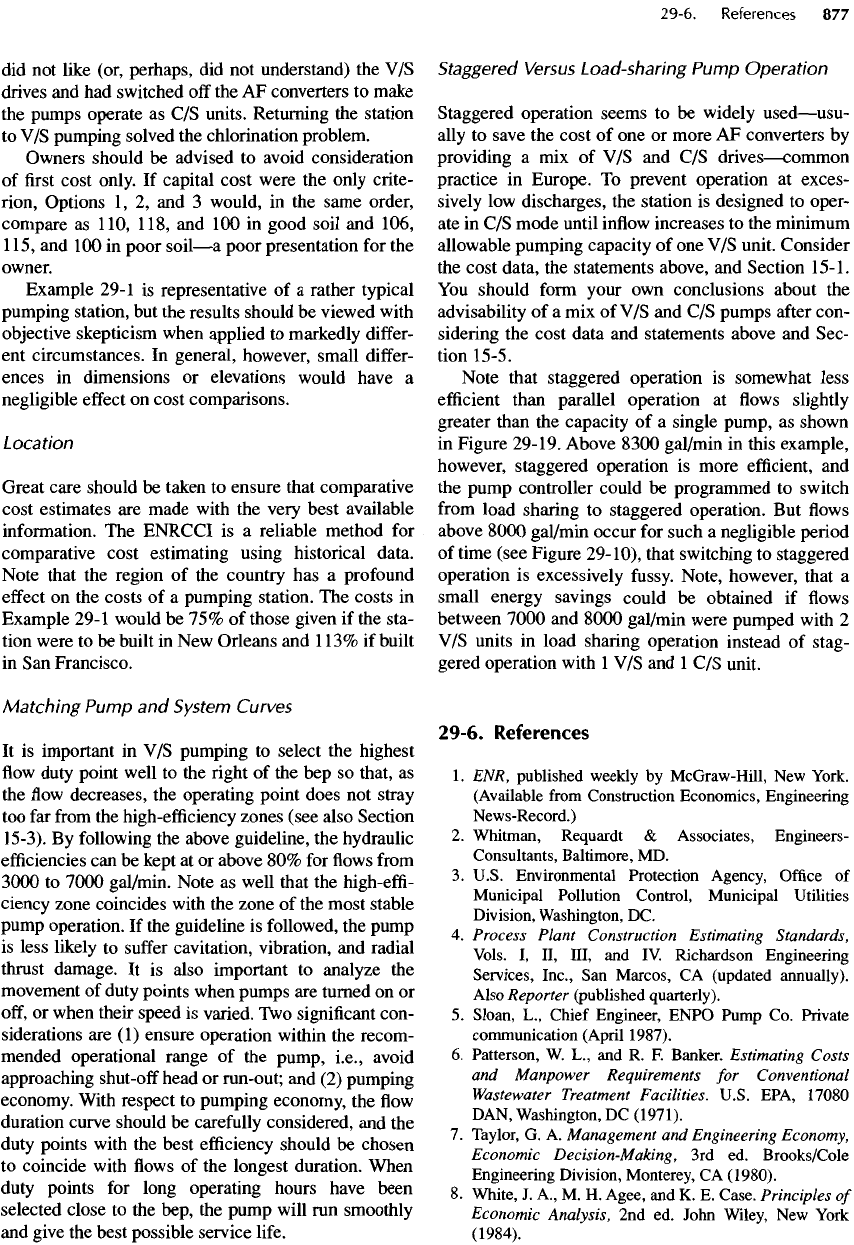
did
not
like (or, perhaps,
did not
understand)
the V/S
drives
and had
switched
off the AF
converters
to
make
the
pumps operate
as C/S
units. Returning
the
station
to V/S
pumping solved
the
chlorination
problem.
Owners
should
be
advised
to
avoid consideration
of
first
cost only.
If
capital cost were
the
only crite-
rion, Options
1, 2, and 3
would,
in the
same order,
compare
as
110,
118,
and 100 in
good soil
and
106,
1
15,
and 100 in
poor
soil
—
a
poor presentation
for the
owner.
Example
29-1
is
representative
of a
rather typical
pumping
station,
but the
results should
be
viewed with
objective
skepticism when applied
to
markedly
differ-
ent
circumstances.
In
general, however, small
differ-
ences
in
dimensions
or
elevations would have
a
negligible
effect
on
cost comparisons.
Location
Great care should
be
taken
to
ensure that comparative
cost estimates
are
made with
the
very best available
information.
The
ENRCCI
is a
reliable method
for
comparative cost estimating using historical data.
Note
that
the
region
of the
country
has a
profound
effect
on the
costs
of a
pumping station.
The
costs
in
Example 29-1 would
be 75% of
those given
if the
sta-
tion
were
to be
built
in New
Orleans
and
1
13%
if
built
in
San
Francisco.
Matching Pump
and
System Curves
It is
important
in V/S
pumping
to
select
the
highest
flow
duty
point well
to the right of the bep so
that,
as
the
flow
decreases,
the
operating point does
not
stray
too far
from
the
high-efficiency
zones (see also Section
15-3).
By
following
the
above guideline,
the
hydraulic
efficiencies
can be
kept
at or
above
80% for flows
from
3000
to
7000
gal/min.
Note
as
well that
the
high-effi-
ciency zone coincides with
the
zone
of the
most stable
pump
operation.
If the
guideline
is
followed,
the
pump
is
less likely
to
suffer
cavitation, vibration,
and
radial
thrust
damage.
It is
also important
to
analyze
the
movement
of
duty points when pumps
are
turned
on or
off,
or
when their speed
is
varied.
Two
significant
con-
siderations
are (1)
ensure operation within
the
recom-
mended operational range
of the
pump, i.e., avoid
approaching
shut-off
head
or
run-out;
and (2)
pumping
economy. With respect
to
pumping economy,
the flow
duration
curve should
be
carefully
considered,
and the
duty
points with
the
best
efficiency
should
be
chosen
to
coincide with
flows of the
longest duration. When
duty
points
for
long operating hours have been
selected close
to the
bep,
the
pump will
run
smoothly
and
give
the
best possible service
life.
Staggered
Versus
Load-sharing Pump Operation
Staggered operation seems
to be
widely
used
—
usu-
ally
to
save
the
cost
of one or
more
AF
converters
by
providing
a mix of V/S and C/S
drives
—
common
practice
in
Europe.
To
prevent operation
at
exces-
sively
low
discharges,
the
station
is
designed
to
oper-
ate in C/S
mode until
inflow
increases
to the
minimum
allowable pumping capacity
of one V/S
unit. Consider
the
cost data,
the
statements above,
and
Section
15-1.
You
should
form
your
own
conclusions about
the
advisability
of a mix of V/S and C/S
pumps
after
con-
sidering
the
cost data
and
statements above
and
Sec-
tion 15-5.
Note that staggered operation
is
somewhat less
efficient
than parallel operation
at flows
slightly
greater than
the
capacity
of a
single pump,
as
shown
in
Figure 29-19. Above
8300
gal/min
in
this example,
however, staggered operation
is
more
efficient,
and
the
pump controller could
be
programmed
to
switch
from
load sharing
to
staggered operation.
But flows
above
8000
gal/min occur
for
such
a
negligible period
of
time (see Figure 29-10), that switching
to
staggered
operation
is
excessively
fussy.
Note, however, that
a
small energy savings could
be
obtained
if flows
between
7000
and
8000
gal/min were pumped with
2
V/S
units
in
load sharing operation instead
of
stag-
gered operation with
1 V/S and 1 C/S
unit.
29-6.
References
1.
ENR, published weekly
by
McGraw-Hill,
New
York.
(Available
from
Construction Economics, Engineering
News-Record.)
2.
Whitman, Requardt
&
Associates,
Engineers-
Consultants, Baltimore,
MD.
3.
U.S. Environmental
Protection
Agency,
Office
of
Municipal Pollution
Control,
Municipal Utilities
Division, Washington,
DC.
4.
Process Plant Construction Estimating Standards,
VoIs.
I, II,
III,
and IV.
Richardson Engineering
Services, Inc.,
San
Marcos,
CA
(updated annually).
Also Reporter (published quarterly).
5.
Sloan,
L.,
Chief Engineer, ENPO Pump
Co.
Private
communication (April
1987).
6.
Patterson,
W.
L.,
and R. F.
Banker. Estimating Costs
and
Manpower
Requirements
for
Conventional
Wastewater
Treatment Facilities. U.S. EPA,
17080
DAN, Washington,
DC
(1971).
7.
Taylor,
G. A.
Management
and
Engineering Economy,
Economic Decision-Making,
3rd ed.
Brooks/Cole
Engineering Division, Monterey,
CA
(1980).
8.
White,
J.
A.,
M. H.
Agee,
and K. E.
Case.
Principles
of
Economic Analysis,
2nd ed.
John Wiley,
New
York
(1984).
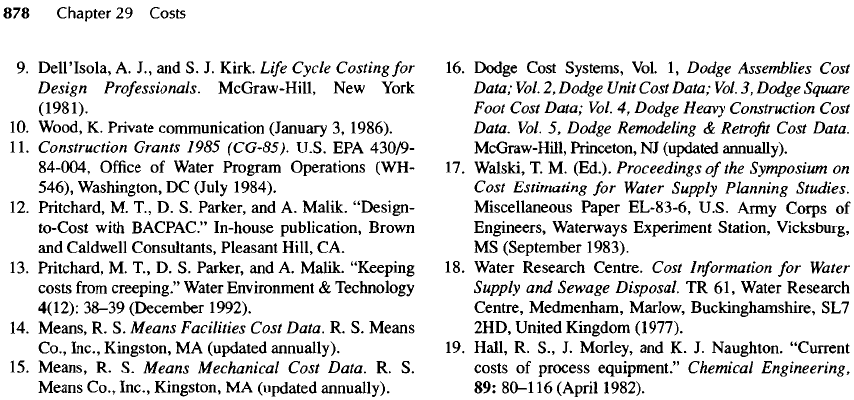
9.
Dell'Isola,
A.
J.,
and S. J.
Kirk.
Life
Cycle
Costing
for
Design Professionals. McGraw-Hill,
New
York
(1981).
10.
Wood,
K.
Private communication (January
3,
1986).
11.
Construction Grants 1985
(CG-85).
U.S.
EPA
430/9-
84-004,
Office
of
Water Program Operations (WH-
546), Washington,
DC
(July 1984).
12.
Pritchard,
M.
T.,
D. S.
Parker,
and A.
Malik.
"Design-
to-Cost with BACPAC."
In-house
publication, Brown
and
Caldwell
Consultants, Pleasant Hill,
CA.
13.
Pritchard,
M.
T.,
D. S.
Parker,
and A.
Malik. "Keeping
costs
from
creeping." Water Environment
&
Technology
4(12):
38-39
(December 1992).
14.
Means,
R. S.
Means Facilities Cost Data.
R. S.
Means
Co., Inc., Kingston,
MA
(updated annually).
15.
Means,
R. S.
Means Mechanical Cost Data.
R. S.
Means Co., Inc., Kingston,
MA
(updated annually).
16.
Dodge Cost Systems, Vol.
1,
Dodge
Assemblies Cost
Data;
Vol.
2,
Dodge
Unit
Cost
Data;
Vol.
3,
Dodge
Square
Foot
Cost
Data; Vol.
4,
Dodge
Heavy
Construction Cost
Data. Vol.
5,
Dodge
Remodeling
&
Retrofit
Cost Data.
McGraw-Hill, Princeton,
NJ
(updated annually).
17.
Walski,
T. M.
(Ed.).
Proceedings
of
the
Symposium
on
Cost
Estimating
for
Water
Supply
Planning Studies.
Miscellaneous Paper EL-83-6, U.S. Army Corps
of
Engineers,
Waterways
Experiment
Station,
Vicksburg,
MS
(September
1983).
18.
Water Research Centre. Cost
Information
for
Water
Supply
and
Sewage Disposal.
TR
61,
Water Research
Centre,
Medmenham,
Marlow,
Buckinghamshire,
SL7
2HD,
United Kingdom (1977).
19.
Hall,
R.
S.,
J.
Morley,
and K. J.
Naughton. "Current
costs
of
process
equipment." Chemical Engineering,
89:
80-1
16
(April 1982).
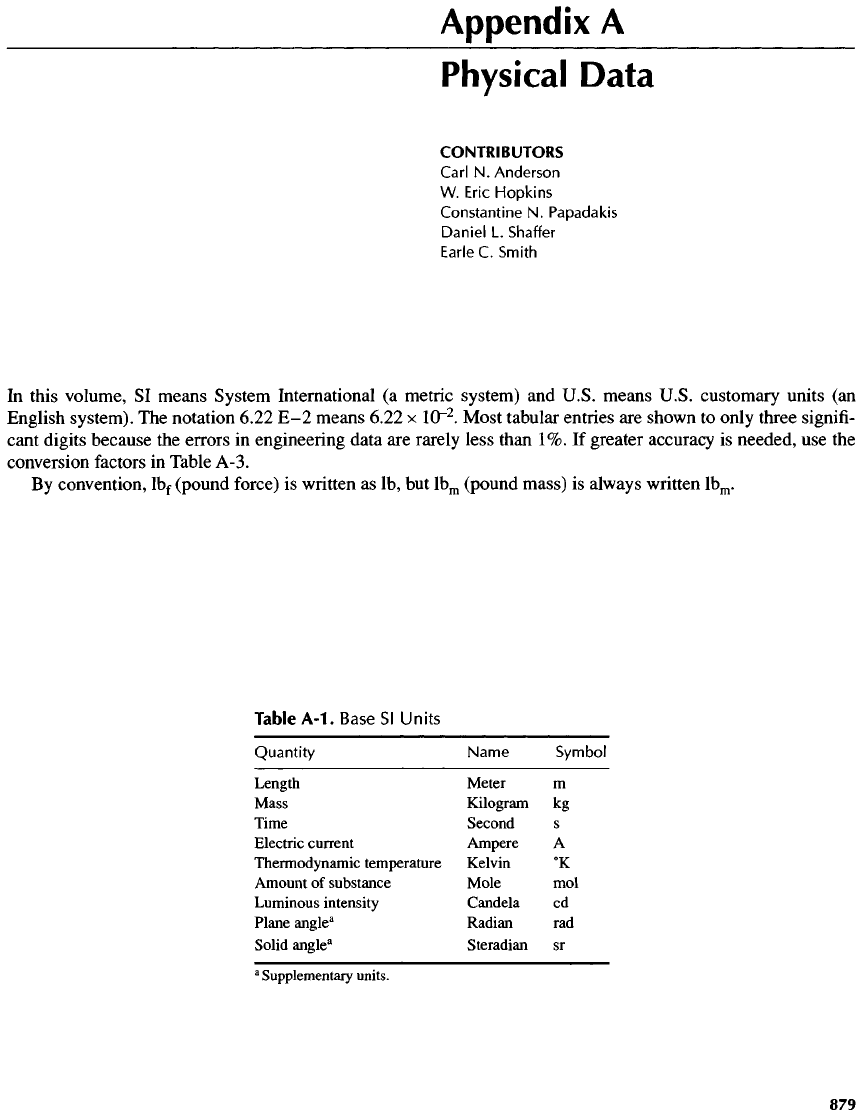
Appendix
A
Physical
Data
CONTRIBUTORS
Carl
N.
Anderson
W.
Eric
Hopkins
Constant!ne
N.
Papadakis
Daniel
L.
Shaffer
Earle
C.
Smith
In
this volume,
SI
means System International
(a
metric system)
and
U.S.
means
U.S.
customary units
(an
English system).
The
notation
6.22
E-2
means
6.22
x
10~
2
.
Most tabular entries
are
shown
to
only three
signifi-
cant digits because
the
errors
in
engineering data
are
rarely less than
1%.
If
greater accuracy
is
needed,
use the
conversion factors
in
Table
A-3.
By
convention,
lb
f
(pound force)
is
written
as
Ib,
but
lb
m
(pound mass)
is
always written
Ib
1n
.
Table
A-1.
Base
Sl
Units
Quantity Name Symbol
Length
Meter
m
Mass Kilogram
kg
Time Second
s
Electric
current Ampere
A
Thermodynamic
temperature Kelvin
0
K
Amount
of
substance
Mole
mol
Luminous intensity Candela
cd
Plane
angle
3
Radian
rad
Solid
angle
a
Steradian
sr
a
Supplementary
units.
